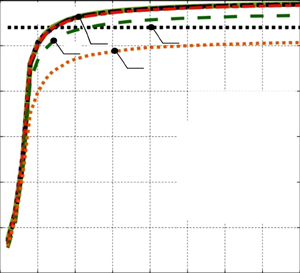Selection of parameters for band-diagonal regularization of maximum likelihood estimates of Gaussian interference correlation matrices and their inverses
DOI:
https://doi.org/10.3103/S0735272721050010Keywords:
Gaussian noise jamming, Gaussian clutter, space-time adaptive processing, maximum likelihood estimate, correlation matrix, band-diagonal regularization parameters, speedAbstract
This study is devoted to the substantiation of practical recommendations on the selection of parameters for the band-diagonal regularization of maximum likelihood estimates of Hermitian correlation matrices of Gaussian interferences. These parameters include the diagonal regularization parameter and band regularization parameter, which represents the compensation multiplicity, i.e., the number of stages of adaptive lattice filters, for ensuring the high speed of adaptation of radar protection systems against the noise jamming and clutter corresponding to the theoretical (ultimate) limit. It has been shown that during the adaptive spatial processing of signals against the background of noise jamming, the selection of diagonal regularization parameter depends on the dimension of problem, while during the time processing of signals against the background of clutter, it also depends on the shape of correlation function of such interferences. The limitation of the number of stages of adaptive lattice filters as compared with the number of time channels makes it possible to simplify the adaptive processing of signals against the background of clutter and at the same time to increase the speed of adaptation.
References
- Y. D. Shirman, S. T. Bagdasaryan, A. S. Malyarenko, D. I. Lekhovitskii, Radio Electronic Systems. Principles of Construction and Theory. Reference Book, [in Russian]. Moscow: Radiotekhnika, 2007.
- S. Ahmed, F. Abbasi, U. I. Ahmed, “Radar jamming suppression using clipping based pulse integration,” in NAECON 2018 - IEEE National Aerospace and Electronics Conference, 2018, vol. 2018-July, pp. 587–591, doi: https://doi.org/10.1109/NAECON.2018.8556736.
- P. Addabbo, O. Besson, D. Orlando, G. Ricci, “Adaptive detection of coherent radar targets in the presence of noise jamming,” IEEE Trans. Signal Process., vol. 67, no. 24, pp. 6498–6510, 2019, doi: https://doi.org/10.1109/TSP.2019.2954499.
- H. Xiao, T. Wang, S. Zhang, C. Wen, “A robust refined training sample reweighting space–time adaptive processing method for airborne radar in heterogeneous environment,” IET Radar, Sonar Navig., vol. 15, no. 3, pp. 310–322, 2021, doi: https://doi.org/10.1049/rsn2.12034.
- R. Gui, W.-Q. Wang, A. Farina, H. C. So, “FDA radar with doppler-spreading consideration: Mainlobe clutter suppression for blind-doppler target detection,” Signal Process., vol. 179, p. 107773, 2021, doi: https://doi.org/10.1016/j.sigpro.2020.107773.
- D. I. Popov, “Clutter parameter estimation based on indirect algorithms,” Radioelectron. Commun. Syst., vol. 62, no. 1, pp. 42–50, 2019, doi: https://doi.org/10.3103/S0735272719010060.
- S. Liu, Y. Ma, Y. Huang, “Sea clutter cancellation for passive radar sensor exploiting multi-channel adaptive filters,” IEEE Sensors J., vol. 19, no. 3, pp. 982–995, 2019, doi: https://doi.org/10.1109/JSEN.2018.2879879.
- I. S. Reed, J. D. Mallett, L. E. Brennan, “Rapid convergence rate in adaptive arrays,” IEEE Trans. Aerosp. Electron. Syst., vol. AES-10, no. 6, pp. 853–863, 1974, doi: https://doi.org/10.1109/TAES.1974.307893.
- R. A. Monzingo, R. L. Haupt, T. W. Miller, Introduction to Adaptive Arrays. IET, 2011, doi: https://doi.org/10.1049/SBEW046E.
- Y. I. Abramovich, “Controlled method for adaptive optimization of filters using the criterion of maximum signal-to-noise ratio,” Radio Eng. Electron. Phys., vol. 25, no. 3, pp. 87–95, 1981.
- Y. I. Abramovich, N. K. Spencer, M. D. E. Turley, “Time-varying autoregressive (TVAR) models for multiple radar observations,” IEEE Trans. Signal Process., vol. 55, no. 4, pp. 1298–1311, 2007, doi: https://doi.org/10.1109/TSP.2006.888064.
- D. I. Lekhovitskii, S. B. Milovanov, I. D. Rakov, B. G. Sverdlov, “Universal adaptive lattice filters. Adaptation for a given root of the estimating correlation matrix,” Radiophys. Quantum Electron., vol. 35, no. 11–12, pp. 621–636, 1992, doi: https://doi.org/10.1007/BF01046658.
- V. G. Repin, G. P. Tartakovskii, Statistical Synthesis on Condition of A Priori Uncertainty and Adaptation of Information Systems, [in Russian]. Moscow: Sov. Radio, 1977.
- D. I. Lekhovytskiy, D. S. Rachkov, A. V. Semeniaka, V. P. Ryabukha, D. V. Atamanskiy, “Adaptive lattice filters. Part I. Theory of lattice structures,” Appl. Radio Electron., vol. 10, no. 4, pp. 380–404, 2011, uri: https://openarchive.nure.ua/bitstream/document/4699/1/380-404.pdf.
- D. I. Lekhovytskiy, “Adaptive lattice filters for systems of space-time processing of non-stationary Gaussian processes,” Radioelectron. Commun. Syst., vol. 61, no. 11, pp. 477–514, 2018, doi: https://doi.org/10.3103/S0735272718110018.
- Y. I. Abramovich, N. K. Spencer, B. A. Johnson, “Band-inverse TVAR covariance matrix estimation for adaptive detection,” IEEE Trans. Aerosp. Electron. Syst., vol. 46, no. 1, pp. 375–396, 2010, doi: https://doi.org/10.1109/TAES.2010.5417169.
- D. I. Lekhovytskiy, Y. I. Abramovich, V. P. Ryabukha, G. A. Zhuga, D. S. Rachkov, A. V. Semeniaka, “Band-diagonal regularization of Gaussian interference covariance matrices ML estimates for adaptive signal processing applications,” Appl. Radio Electron., vol. 10, no. 4, pp. 419–422, 2011.
- V. P. Riabukha, A. V. Semeniaka, Y. A. Katiushyn, “Mathematical models of cross-correlated and uncorrelated Gaussian noise jamming from external sources,” Radioelectron. Commun. Syst., vol. 64, no. 3, pp. 147–154, 2021, doi: https://doi.org/10.3103/S0735272721030043.
- D. I. Lekhovytskiy, I. G. Kirillov, “The simulation of clutters for pulse radars on the basis of processes of random order autoregression,” Inf. Process. Syst., no. 3, pp. 90–101, 2008.


